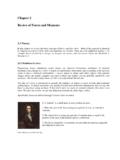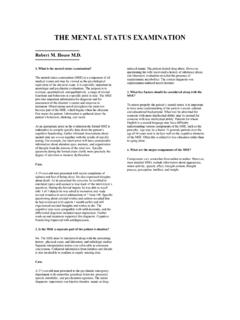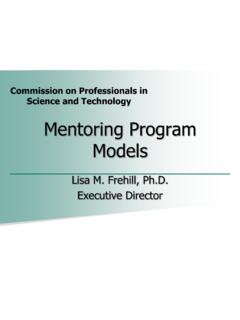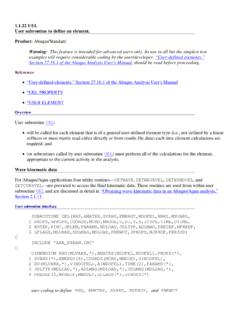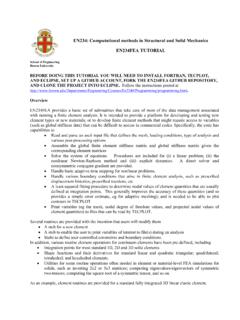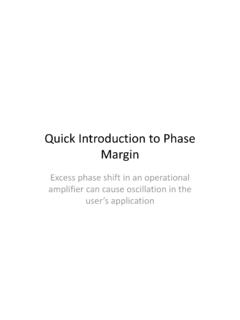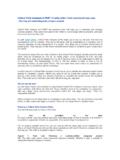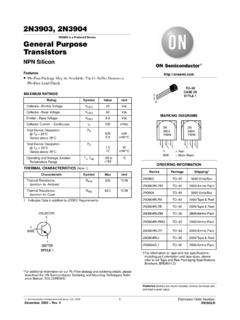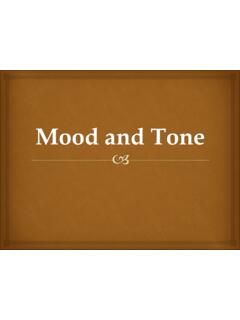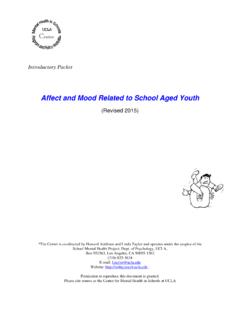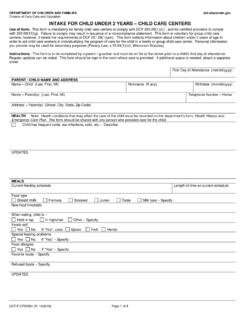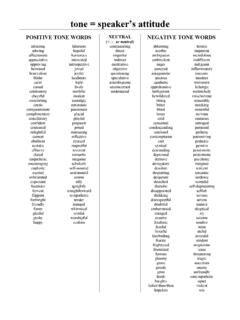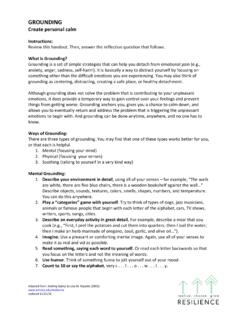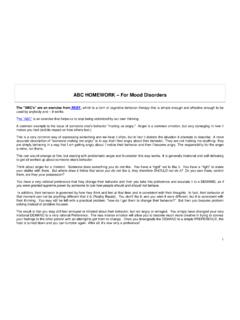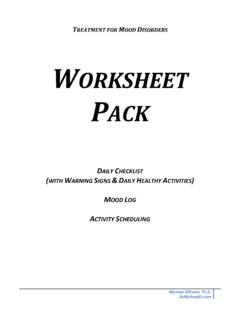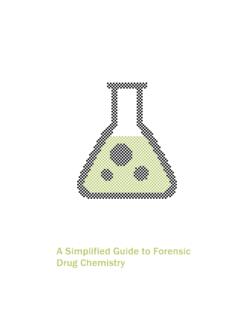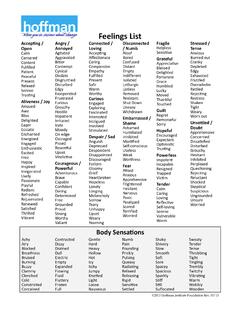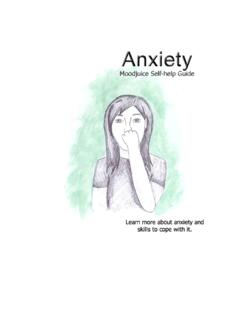Transcription of The Clinical Presentation of Mood Disorders. Bob Boland MD ...
1 The Clinical Presentation of mood Disorders. Bob Boland MD Slide 1 The Clinical Presentation of mood Disorders Slide 2 Concentrating On Depression Major Depression Mania Bipolar Disorder (Manic-Depression) For the mood disorders, we re going to have to cover both depression AND mania. Slide 3 Phenomenology: The Mental Status Exam General Appearance Emotional Thought Cognition Judgment and Insight Reliability Once again, we ll use the mental status exam to consider the phenomenology of the mood disorders. Slide 4 General Appearance Depression Mania In both cases, people may look normal with mood disorders.
2 However, as the disorder worsens, often appearance is affected. Though one can imagine a variety of appearances, typically we see depressed patients taking less care of their appearance, whereas manic patients may be more flamboyant. Slide 5 Emotions: Depression mood Dysphoric Irritable, angry Apathetic Affect Blunted, sad, constricted I prefer the word dysphoric ( , feeling bad ) to depressed in describing the typical sad mood of the depressed patient. However patients may not be simply sad. They may be more irritable, angry, or feel like they have no emotion at all. Their affect may be sad, but it could also be blunted, or show less emotion altogether.
3 Slide 6 Emotions: Mania mood Euphoric Irritable Affect Heightened, dramatic, labile The typical manic mood is euphoria. However, again, patients may instead be irritable. Typically, manic patients are animated with exaggerated emotional styles. Clinical Presentation of mood DisordersPage 2 of 14 Slide 7 Thought: Depression Process Slowed processing Thought blocking Content Everything s awful Guilty, self-deprecating Delusional Depressed people often describe problems with their thoughts thinking more slowly, having trouble organizing their thoughts. In the extreme, they describe feeling as if they are demented.
4 Typically, they see thinks as worse that it really is, and in the extreme, they may become delusional. Slide 8 Thought: Mania Process Rapid Pressured speech Loosening of Associations Content Grandiose Delusions Manic people tend to think more quickly. In the right amounts, the combination of this quick thought, and the somewhat broader associations can make them seem quite clever, but as it worsens, their thinking becomes more incomprehensible. The speech is pressured not only rapid, but continuous, in the sense that they seem as if they will continue talking incessantly unless interrupted. The content of thought is typically grandiose ex.
5 Thinking one is more important than they are, richer, more attractive, etc. In the extreme they can be delusional. Slide 9 Cognition Depression Poor attention Registration Effort Pseudodementia Mania Distractible Concentration May seem brighter, more clever As already noted, depression can affect thought, to the point where patients cannot concentrate as well. As a result, they may find it harder to learn or remember things. The term pseudodementia has been applied to this, but it is probably best not used, as depression can affect cognition in a variety of ways, both in terms of actual thought processing, and in the effort applied to answering questions.
6 In the right amount, a manic patient can be very clever and certainly some of the brighter people around have had bipolar disorder. However, with worsening of the disorder, this worsens as well. Clinical Presentation of mood DisordersPage 3 of 14 Slide 10 Insight and Judgment Depression Unrealistically negative Mania Unrealistically positive Or just plain bad One can imagine that as thought worsens, so does insight and judgment. For example, if one thinks they are hopeless and worthless, it will certainly affect their decisions about future plans. Similarly, a manic person can be unrealistically optimistic and make poor decisions: ex.
7 Buying things they cannot really afford. Slide 11 Epidemiology Depression 5-7% 2:1 : $53 billion/year in US World: most costly (developed) Depression is very common 5-7% lifetime risk in the Epidemiological Catchment Area (ECA) Study. Later follow ups suggest it may be even more common than that. It is more common in woman than men this seems to be true worldwide, and most believe this reflects some biological predisposition, though social causes remain possible and plausible. It is one of the most costly diseases known to man, and certainly the most costly in developed countries. This is due to the fact that it often strikes persons during the most productive years of their lives.
8 Though many famous people have suffered from it, this probably has more to do with the fact that this disorder is common, rather than any particular association with creativity. Clinical Presentation of mood DisordersPage 4 of 14 Slide 12 Epidemiology Bipolar Disorders 1% ~1:1 : Bipolar disorder is somewhat less common. The gender difference is closer to parity. Though many very productive and creative people have had the disorder, they usually have not been productive during highs and lows of the disorder. Slide 13 Diagnosis and Criteria Episodes Versus Disorders In diagnosing the mood disorders, one should be aware that DSM describes first episodes, which are syndromes, or collections of symptoms, which then become the building blocks for the actual disorders.
9 Slide 14 Episodes Major depressive Manic Mixed Hypomanic There are the episodes. Once again, remember, these are not diagnoses, merely descriptions of syndromes. Clinical Presentation of mood DisordersPage 5 of 14 Slide 15 Major Depressive Episode Time 2 weeks Change From previous functioning Symptoms 5 or more 1 has to be depressed mood or anhedonia Global Criteria All the episodes are described in terms of time course, a collection of symptoms with a minimum required number, and the global criteria (see the first lecture for more on that). In the case of a major episode, the criteria are listed here.
10 Slide 16 Symptoms of Major Depressive Episode Sig E Caps Sleep Interest Guilt Energy Concentration Appetite Psychomotor retardation Suicide 5 or more These are the symptoms of a major depressive episode. In addition to these, one MUST have either dysphoria or anhedonia (taking no pleasure in anything). SIG E CAPS is a useful mnemonic (like a prescription for energy capsules ) for remembering these symptoms. Slide 17 Manic Episode Time 1 week Symptom list 3 or more Global Criteria Similarly, these are the criteria for a manic episode. The actual symptoms list is on the next slide. Clinical Presentation of mood DisordersPage 6 of 14 Slide 18 Symptoms of Manic Episode Grandiosity Decreased need for sleep Pressured Speech Flight of Ideas Distractibility Increased Activity/Agitation Risky Activities 3 or more Slide 19 Other Episodes Mixed Hypomanic In addition to those (which I want to concentrate on) there are 2 other types of episodes: a mixed episode and a hypomanic episode.
